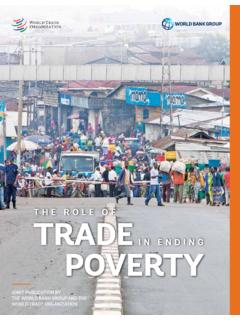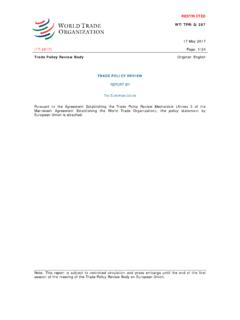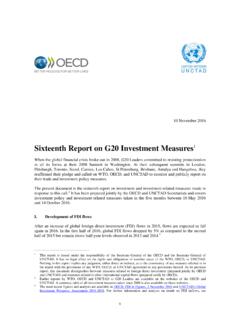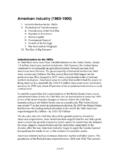Transcription of B. Trends in international trade - World Trade Organization
1 World Trade report 201344A comprehensive and fruitful analysis of the shaping factors of international Trade and their implications for Trade policy cannot be performed without having a clear idea of the evolution of Trade patterns over time. This part of the Report analyses past, present and future Trends in international Trade and economic activity. It begins with a historical analysis of Trade developments from pre-industrial times to the present, focusing on the key role that technology and institutions have played in the past. It then identifies and explains important Trends in international Trade that have emerged over the last 30 years.
2 In doing so, the section describes who the main players are in international Trade (in terms of countries or companies), what countries Trade and with whom, and how the nature of Trade has changed over time. Finally, it provides some illustrative simulations of possible future Trade Trends in international tradeII Factors shapIng the Future oF World trade45fifi fi fi fi Contents 1 The evolution of international Trade : insights from economic history 46 2 How has Trade changed in the last 20-30 years? 55 3 Future economic and Trade scenarios 89 4 Conclusions 103 Appendix tables 109 Some key facts and findings Dramatic decreases in transport and communication costs have been the driving forces behind today s global trading system.
3 Geopolitics has also played a decisive role in advancing and reinforcing these structural Trends . In the last 30 years, World merchandise and commercial services Trade have increased by about 7 per cent per year on average, reaching a peak of US$ 18 trillion and US$ 4 trillion respectively in 2011. When Trade is measured in value-added terms, services play a larger role. Between 1980 and 2011, developing economies raised their share in World exports from 34 per cent to 47 per cent and their share in World imports from 29 per cent to 42 per cent. Asia is playing an increasing role in World Trade .
4 For a number of decades, World Trade has grown on average nearly twice as fast as World production. This reflects the increasing prominence of international supply chains and hence the importance of measuring Trade in value-added terms. Simulations show that in a dynamic economic and open Trade environment, developing countries are likely to outpace developed countries in terms of both export and GDP growth by a factor of two to three in future decades. By contrast, their GDP would grow by less than half this rate in a pessimistic economic and protectionist scenario, and export growth would be lower than in developed Trade report 2013461.
5 The evolution of international Trade : insights from economic historyUnderstanding the future shaping factors of World Trade begins with an understanding of the historical forces that created the global trading system we have today. The rise of a World trading system, like so many other features of the modern World economy, began largely with the industrial revolution. The immense technological advances in transportation and communications that it unleashed from steamships, railroads and telegraphs to automobiles, aeroplanes and the internet steadily reduced the cost of moving goods, capital, technology, and people around the globe.
6 This death of distance , to use the modern metaphor, has been one of the most important forces shaping global economic development since the early 1800s (Cairncross, 1997). The rise of a World economy, the spread of investment and technology, the growth of international specialization, the ascent of new economic powers, the dramatic surge in growth and population none of this in turn would have been possible without a massive expansion of global Trade over the past 200 years. At the same time, the spread of industrialization first to Europe, next to the Americas, and then to Asia, Africa and elsewhere fuelled a further expansion of international Trade and economic integration.
7 Since the mid-1800s, the World s population has grown roughly six-fold, World output has grown 60-fold, and World Trade has grown over 140-fold (Maddison, 2008). This virtuous circle of deepening integration and expanding growth is what we now refer to as underlying technological and structural forces are the main drivers behind globalization, political forces play an equally central role sometimes facilitating and cushioning the rise of a globally integrated market, other times resisting or reversing it. Karl Polanyi s insight that a global free market is not only impossible, but doomed to self-destruction in the absence of effective international cooperation looks as valid today as it did when he first advanced it in 1944 (Polanyi, 1944).
8 It is difficult to imagine the rise of globalization during the 19th century without the gold standard, the dense web of bilateral Trade agreements, and Great Britain s economic dominance, just as it is difficult to imagine the post-1945 resumption of globalization without the advent of the new multilateral economic institutions, more activist economic and social policies at the domestic level, and America s assumption of the global leadership mantle. Indeed, the evolution of globalization over the past 200 years has generally been accompanied not by a contraction of government but by its steady expansion at both the national and international level (see Section ).
9 Yet at other times, politics has intervened sometimes consciously, sometimes accidentally to slow down or even roll back the integrationist pressures of technology and markets. It is this complex interplay of structural and political forces that explains the successive waves of economic integration and disintegration over the past 200 years; and in particular how the seemingly inexorable rise of the first age of globalization in the 19th century was abruptly cut short between 1914 and 1945 by the related catastrophes of the First World War, the Great Depression and the Second World War only to be followed by the rise of a second age of globalization during the latter half of the 20th century.
10 While the long-term trend has been in the direction of expanding Trade and deeper integration, unpredicted (and perhaps unpredictable) geopolitical shocks have periodically interrupted or reversed this trend, suggesting the need for caution in extrapolating from the economic past into the economic future. (a) The first age of globalizationThe early 19th century marked a major turning point for World Trade . Although the outlines of a World economy were already evident in the 17th and 18th centuries as advances in ship design and navigation led to Europe s discovery of the Americas, the opening up of new routes to Asia around Africa, and Magellan s circumnavigation of the globe (Maddison, 2008)











